Henry Akins - "Invisible Jiu-Jitsu" The Concept Of Connection.
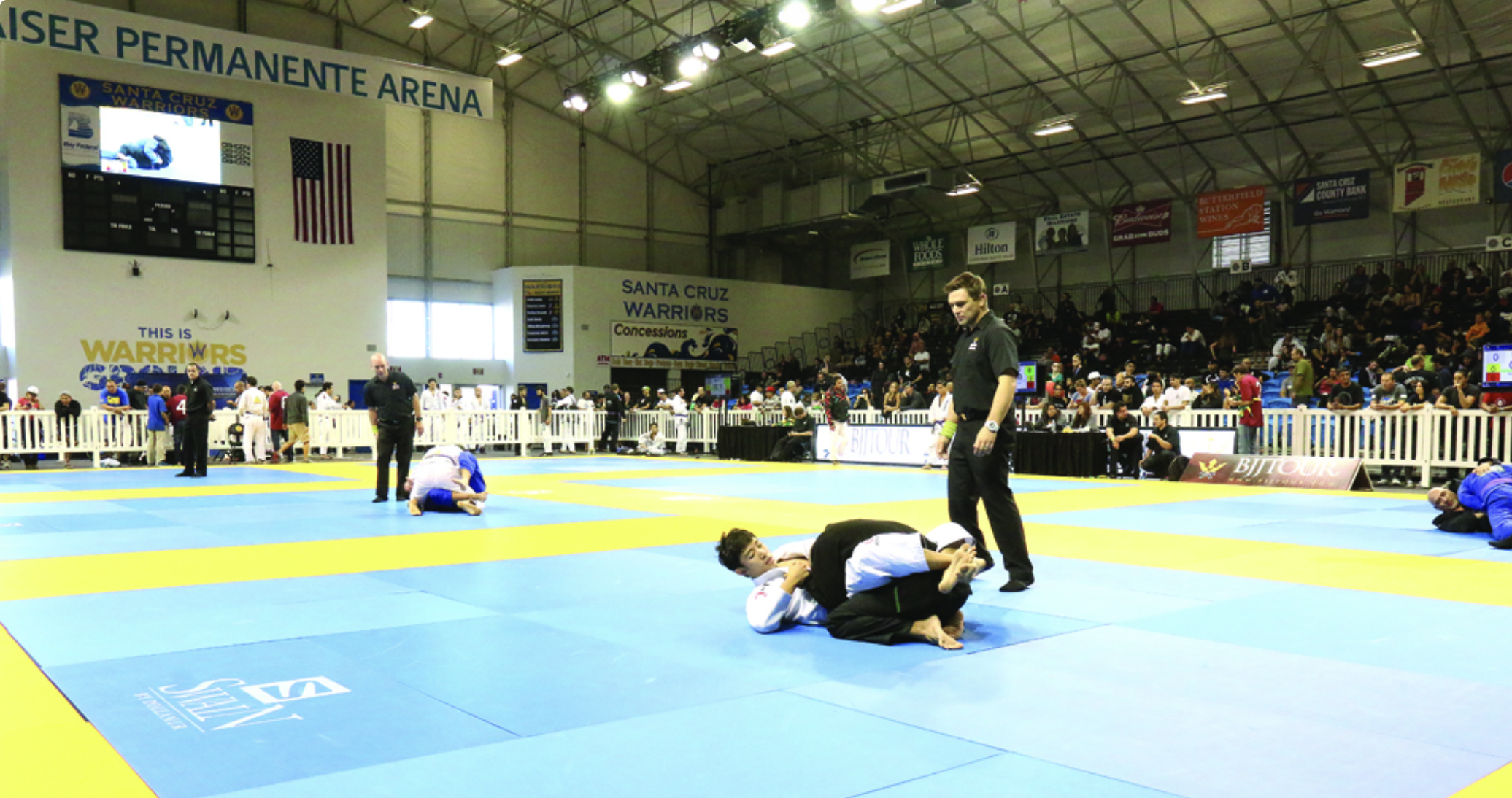
There’s a certain mystique that surrounds Rickson Gracie, much of that aura can be attributed to what he calls “invisible” jiu-jitsu. It’s the jiu-jitsu that you cannot see, but you can feel. Having had the pleasure of being the “demonstration dummy” with Rickson, I can personally attest to the powers of his unique brand of invisible jiu-jitsu. About a year ago I had the chance to roll with Henry Akins. Henry is the third American to have earned his black belt under Rickson Gracie. Henry teaches the fundamentals, as well as the finer points of invisible jiu-jitsu. The first time we met Henry, the purpose was to learn the concept of weight distribution. The interviews and the training with Henry that allowed me to write that article (Issue 19) have had a profound impact on my own jiu-jitsu. Just that one element, weight distribution, has changed my approach to my side control, mount, and some bottom positions. Even a year later I feel like an absolute novice employing this concept. So, when the opportunity arose to train with Henry again and learn the concept of “connection,” I jumped at the chance.
Henry explains the idea of connection this way, “The idea of connection is at the essence of what Rickson calls “invisible” jiu-jitsu. At the core level of jiu-jitsu that’s all we’re trying to do. The connection is what enables us to be effective. The connection is the ability to transfer your energy to another person so that when you move, your opponent feels the effects of it.”
In this article Henry is going to tell us about the core elements of connection and illustrate some of the finer points during various examples. I will do my absolute best to explain each one in words however, if there were ever an article meant for video, it’s this one. Head on over to our new website, jiujitsumag.com, to see the videos associated with this article.
The Broad Concept
Think of connection as being fused with your partner. Think of the scene in any sci-fi movie where the alien comes down to earth and he places his hand on top of the human’s head. There’s that point that’s beyond just simple touch where the hand melds to the head and the alien is downloading every memory, every thought, experience, etc. That’s connection; it’s not just contact. In jiu-jitsu, at the highest level of connection, it would be like being so connected with your opponent that you can feel or sense their movement even before their intention is visible. You’d feel the muscles tightening before they fire. Of course, that would be a huge upper hand for the person realizing the intentions before they happen. On a simpler level, connection would be having no slack in the grips of your holds. You can grab someone’s sleeve and have a good grip of the fabric, but that slack between their arm and your fingers is different than having a grip so tight there’s no slack in the gi and your clenched fist is against their elbow. There’s no room for them to move without you having something to say about it.
During my time with Henry on this subject it was amazing how simple some of the minor adjustments he made were. Many of which I do already, but not consciously knowing it. After our session I went back to my own training and focused solely on recognizing connection versus contact, when I could employ the concept, and when I was missing an opportunity. This simple idea has brought me back down to feeling like an absolute beginner as I look to expand my jiu-jitsu with the recognition and use of this concept. So, let’s get on with some of Henry’s examples of connection in use.
Standing
To illustrate connection while standing the two of us squared up face-to-face and Henry placed his hand on my shoulder. He asked me to walk towards him. His common neutral stance was easy for me to progress into, causing him to take a step back as I pushed forward. When Henry made a connection to my shoulder, with the same stance, he started by anchoring his feet to the ground by slightly shifting his weight to his forward foot. His muscles tensed to be in a state of readiness to apply more weight distribution to his forward foot, anticipating that I would come towards him. The tightening of his body made it nearly impossible for me to move him from his position when I walked towards him with the same amount of force, or any force for that matter. Henry essentially took all the slack out of his body so that the moment he felt the application of force, his resistance was immediate. The harder I pushed the more planted he was.
Application: The obvious application for this is in a tournament situation or any sparring starting from standing. Even though we might be amped on adrenaline and in our minds, ready for anything, it’s plain to see that this idea is not in use during most matches. When we see two competitors pulling and pushing each other around the mats the story might be different if one were to connect to the other. The other application is in a self-defense situation. Maybe you’re in a crowded environment and you’ve got your 95-year-old grandmother trying to make her way behind you, or a young child. The crowd is pushing towards you and them. Making connection might help avoid a disaster.
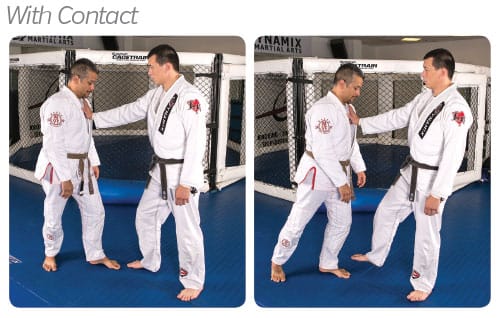
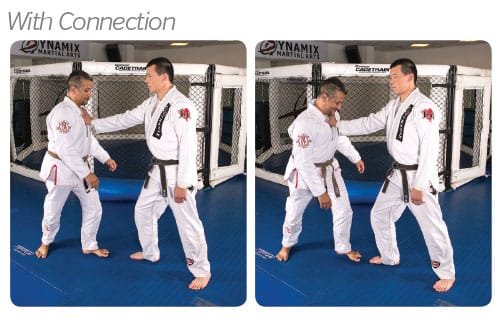
The Guillotine
Henry put me in a standard guillotine with a solid grasp of my neck, his arm wrapped around the back and his legs around me in a closed guard. Henry first applied downward force to his legs to stretch me out while peeling back on his grip of my neck to finish. There was a lot of movement in Henry’s legs and body that I could “feel” and see when I watched the video. To employ connection, Henry made no adjustments to his hold on my neck, but instead, tightening his legs, squeezing his knees together, to the closed guard. Starting from the same beginning position, it was crazy how quickly I felt the choke set in.
Application: We’ve all seen it before, someone’s going for the guillotine, they’re all stretched out, but the tap never comes. Maybe at the end, after they’re fully stretched, they squeeze their knees, but at that point it’s too late. Henry tightened his grip on my body before putting his hips into the stretch. Whenever you have someone in your closed guard, you shouldn’t just rely on the fact that your feet are crossed behind them. Instead, stiffen your legs, and squeeze your knees together to lessen the amount of movement needed to finish that guillotine, or kimura. This will also help your ability to maintain a closed guard if that’s what you want to do. The lack of space between your legs and your opponent might mean his favorite opening technique is useless. Experiment with this. Don’t go crazy trying to squeeze out a tap, you’ll burn yourself out and waste a lot of energy. Find that balance where you can feel your opponent enough to anticipate his next move, stymie his plans and be better positioned to impose your will.

For more techniques from Henry Click HERE
The Mount
This example goes along with the previous one on the guillotine. There are different ways of playing on top in mount. For me, I was unsure of the mount; I felt that my balance wasn’t acute enough to avoid the escape. Interviewing Xande Ribeiro for Issue 7 helped out my mount a lot, but for the most part I’ve looked as my weight as being the downward force to apply on my opponent. My movements from there were typically reactionary to avoid a reversal while figuring out what I wanted to do with the position. To illustrate the connection in the mount, Henry had me mount him and position my body how I would normally. He then had me close my eyes while he would begin to move his body as if he were going to attempt an escape. I had to indicate which direction I thought he was going as soon as I could tell. He did this a few times with my answer being correct, but typically not until he was already far into the escape. Then he had me make a simple adjustment. He had me move up a bit higher on the mount with my inner thighs near the rib cage and tighten my legs so that I was squeezing on his ribs. We repeated the process with my eyes closed. This time I was able to accurately feel which way he was turning before there was any actual movement of his body. I could literally feel his muscles tightening.
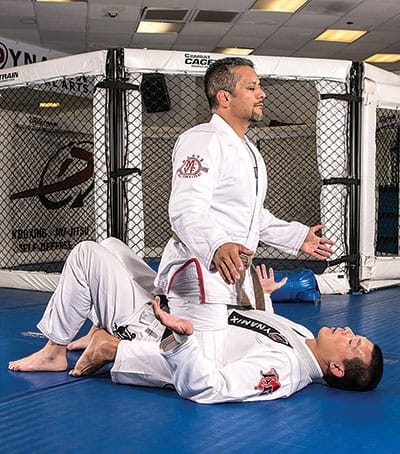
The fact that my eyes were closed may have heightened my sense of touch, but even with my eyes open it was crazy how the lack of any slack between my legs and Henry’s body allowed me to literally feel his intention before it was visible.
Application: If you move into the mount and (sort of) relax a bit until your next move, you’re going to have to break that habit when employing connection. It took a little getting used to for me, squeezing those legs together. However, since doing this photo shoot I’ve been practicing this concept regularly from the mount. It’s allowed me to recognize the direction my opponent wants to turn quickly enough for me to set up for technical mount, and from there it’s bow and arrow all day! It’s also helped me secure the mount position by being able to sometimes instantaneously counter any attempt at an escape.
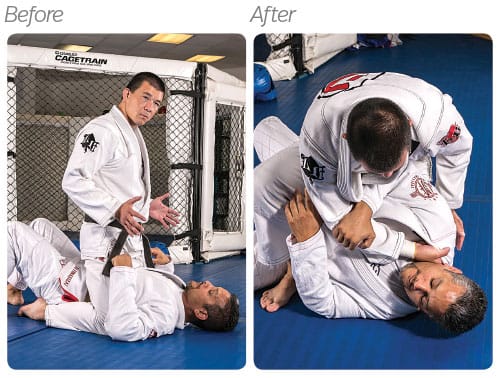
Rigidity
Our bodies are a collection of muscles, that with the right impulses, can become soft and limp, or strong and rigid. Henry illustrated this point with a simple escape from side control. I had Henry in my side control and he used his left arm under my chest. In the first example, Henry contacted my chest with his arm and bridged as if to throw me off towards his head. With his arm simply contacting me I was able to react and count Henry’s bridging motion before it had any impact on me. The second time around, Henry made the connection and engaged his arm prior to bridging. Essentially, Henry took the slack out of his shoulder joint and chest making his torso and arm one solid piece. That time, when Henry bridged, I had no forewarning and it was much more difficult to defend his escape. Henry’s arm, along with his torso, was engaging me and greatly increased his odds of a successful escape.
Application: This concept is similar to the rigid concept that Nic Gregoriedes shared with us back in Issue 24. The applications are limitless. It can be used in almost any situation, especially in those cases where you must explode with force to get where you want to go. Tightening up prior to the explosion will have a huge impact. Another example could be in a choking situation. Let’s say with a cross collar choke, stiffening the wrists so there’s no slack prior to engaging the arms can help set the choke in immediately.

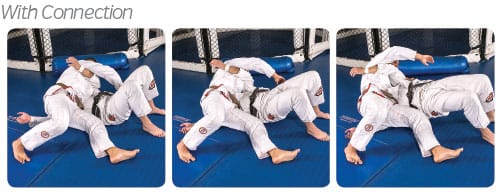
Disconnection
As important as connection – is disconnection. As the aggressor is looking to impose his will on his opponent by use of connection, the target of that force can reduce its influence by breaking the connection, or disconnecting. Henry illustrated this point to me by two ways. The first was actually a refresher on something I learned during weight distribution. Henry put me in full mount and had me place my hand on his chest, post an elbow, and sit up, pushing him off me. We did this a few times to find the moment when connection was made. Once I was comfortable making that connection, Henry simply changed his angle by pulling one shoulder back while driving the other one forward. This instantly killed the connection.
The other example of disconnection came while demonstrating a simple hook sweep. Using my arms and my leg, the emphasis of my connection to Henry was through the leg. I performed the sweep a few times and Henry defended the sweep as most people would, first fighting it, then basing out, but every time I was able to sweep thanks to force being transferred from me to him through the connection. Then Henry proceeded to disconnect. Rather than remaining rigid and fighting the connection through his leg, Henry relaxed the muscles in his leg and allowed it to sort of flop over, essentially not giving me anything to push off of. Time after time this disconnect was effective in thwarting my sweep attempt.
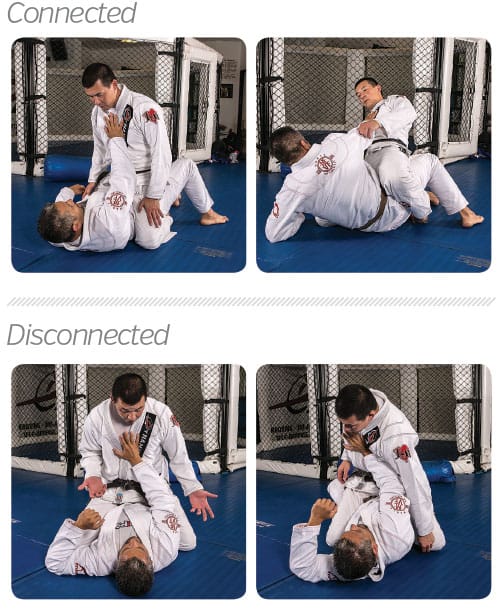
Application: Henry describes jiu-jitsu as a game of manipulation and how you can manipulate your opponent through connection, and stop it through disconnection. This concept of disconnection is applicable in almost every grappling situation. One person wants to move the other, and if you’re on the receiving end, break the connection. Resisting your opponent will often times strengthen his connection. If his angle and leverage are solid you’re only helping him get what he wants. The real test is being able to recognize when the connection is taking place and how to eliminate, or at the very least weaken that connection. Try training as you normally would, but pay special attention to connecting and disconnecting.



There are so many facets of the “invisible” jiu-jitsu that Henry teaches, thanks to his years with Rickson. This article, like the previous one on weight distribution, really just scratches the surface of that knowledge. Once you’re aware of the concept of connection, you can begin to recognize its application every time you train. As you get a greater feel and ability to recognize connection, you’ll be able to use it in almost everything you do. Don’t expect this to happen overnight, because it won’t, it might take years, but sticking with it and continuing to sharpen that skill will bring your jiu-jitsu to an entirely new level. For more on this concept check out the series of videos we produced with Henry available at www.jiujitsumag.com.
About Henry
Henry was at one time the head instructor at the Rickson Gracie Academy. Today, he’s partnered with former UFC fighter Antoni Hardonk as owners of Dynamix Martial Arts in Santa Monica, California. If you don’t live near the Southern California coast nor plan on being in SoCal any time soon, you can catch.
